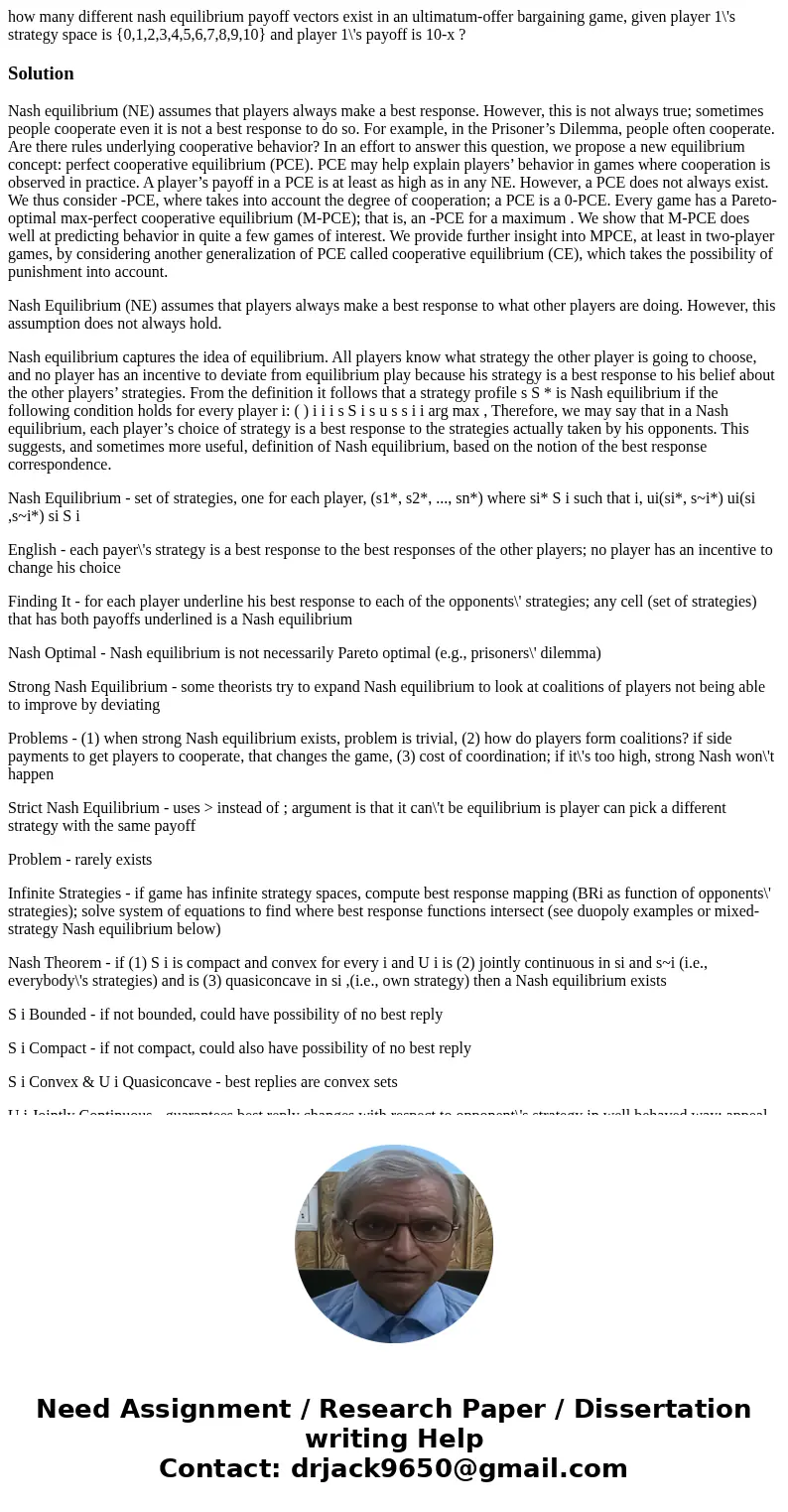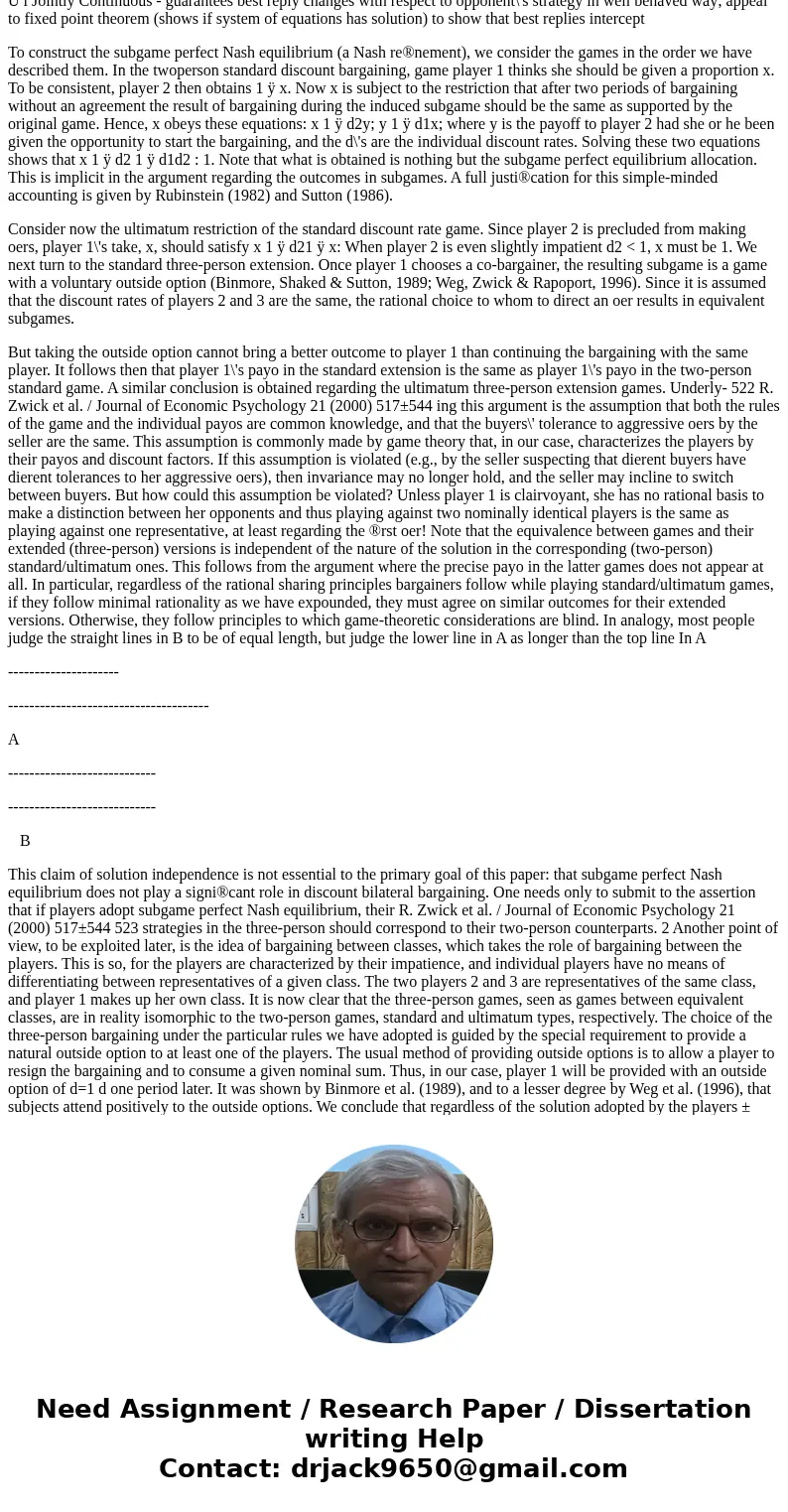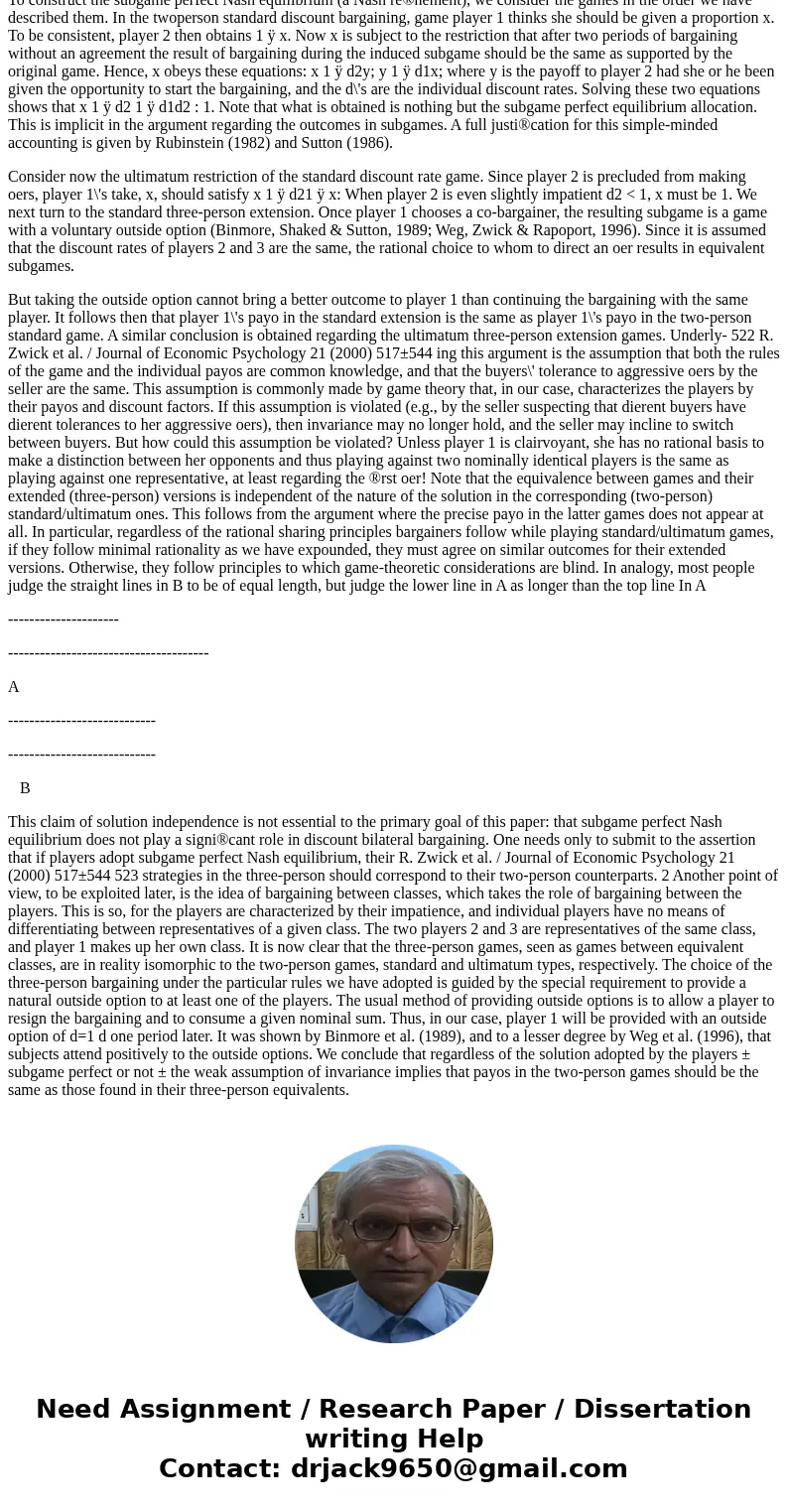how many different nash equilibrium payoff vectors exist in
how many different nash equilibrium payoff vectors exist in an ultimatum-offer bargaining game, given player 1\'s strategy space is {0,1,2,3,4,5,6,7,8,9,10} and player 1\'s payoff is 10-x ?
Solution
Nash equilibrium (NE) assumes that players always make a best response. However, this is not always true; sometimes people cooperate even it is not a best response to do so. For example, in the Prisoner’s Dilemma, people often cooperate. Are there rules underlying cooperative behavior? In an effort to answer this question, we propose a new equilibrium concept: perfect cooperative equilibrium (PCE). PCE may help explain players’ behavior in games where cooperation is observed in practice. A player’s payoff in a PCE is at least as high as in any NE. However, a PCE does not always exist. We thus consider -PCE, where takes into account the degree of cooperation; a PCE is a 0-PCE. Every game has a Pareto-optimal max-perfect cooperative equilibrium (M-PCE); that is, an -PCE for a maximum . We show that M-PCE does well at predicting behavior in quite a few games of interest. We provide further insight into MPCE, at least in two-player games, by considering another generalization of PCE called cooperative equilibrium (CE), which takes the possibility of punishment into account.
Nash Equilibrium (NE) assumes that players always make a best response to what other players are doing. However, this assumption does not always hold.
Nash equilibrium captures the idea of equilibrium. All players know what strategy the other player is going to choose, and no player has an incentive to deviate from equilibrium play because his strategy is a best response to his belief about the other players’ strategies. From the definition it follows that a strategy profile s S * is Nash equilibrium if the following condition holds for every player i: ( ) i i i s S i s u s s i i arg max , Therefore, we may say that in a Nash equilibrium, each player’s choice of strategy is a best response to the strategies actually taken by his opponents. This suggests, and sometimes more useful, definition of Nash equilibrium, based on the notion of the best response correspondence.
Nash Equilibrium - set of strategies, one for each player, (s1*, s2*, ..., sn*) where si* S i such that i, ui(si*, s~i*) ui(si ,s~i*) si S i
English - each payer\'s strategy is a best response to the best responses of the other players; no player has an incentive to change his choice
Finding It - for each player underline his best response to each of the opponents\' strategies; any cell (set of strategies) that has both payoffs underlined is a Nash equilibrium
Nash Optimal - Nash equilibrium is not necessarily Pareto optimal (e.g., prisoners\' dilemma)
Strong Nash Equilibrium - some theorists try to expand Nash equilibrium to look at coalitions of players not being able to improve by deviating
Problems - (1) when strong Nash equilibrium exists, problem is trivial, (2) how do players form coalitions? if side payments to get players to cooperate, that changes the game, (3) cost of coordination; if it\'s too high, strong Nash won\'t happen
Strict Nash Equilibrium - uses > instead of ; argument is that it can\'t be equilibrium is player can pick a different strategy with the same payoff
Problem - rarely exists
Infinite Strategies - if game has infinite strategy spaces, compute best response mapping (BRi as function of opponents\' strategies); solve system of equations to find where best response functions intersect (see duopoly examples or mixed-strategy Nash equilibrium below)
Nash Theorem - if (1) S i is compact and convex for every i and U i is (2) jointly continuous in si and s~i (i.e., everybody\'s strategies) and is (3) quasiconcave in si ,(i.e., own strategy) then a Nash equilibrium exists
S i Bounded - if not bounded, could have possibility of no best reply
S i Compact - if not compact, could also have possibility of no best reply
S i Convex & U i Quasiconcave - best replies are convex sets
U i Jointly Continuous - guarantees best reply changes with respect to opponent\'s strategy in well behaved way; appeal to fixed point theorem (shows if system of equations has solution) to show that best replies intercept
To construct the subgame perfect Nash equilibrium (a Nash re®nement), we consider the games in the order we have described them. In the twoperson standard discount bargaining, game player 1 thinks she should be given a proportion x. To be consistent, player 2 then obtains 1 ÿ x. Now x is subject to the restriction that after two periods of bargaining without an agreement the result of bargaining during the induced subgame should be the same as supported by the original game. Hence, x obeys these equations: x 1 ÿ d2y; y 1 ÿ d1x; where y is the payoff to player 2 had she or he been given the opportunity to start the bargaining, and the d\'s are the individual discount rates. Solving these two equations shows that x 1 ÿ d2 1 ÿ d1d2 : 1. Note that what is obtained is nothing but the subgame perfect equilibrium allocation. This is implicit in the argument regarding the outcomes in subgames. A full justi®cation for this simple-minded accounting is given by Rubinstein (1982) and Sutton (1986).
Consider now the ultimatum restriction of the standard discount rate game. Since player 2 is precluded from making oers, player 1\'s take, x, should satisfy x 1 ÿ d21 ÿ x: When player 2 is even slightly impatient d2 < 1, x must be 1. We next turn to the standard three-person extension. Once player 1 chooses a co-bargainer, the resulting subgame is a game with a voluntary outside option (Binmore, Shaked & Sutton, 1989; Weg, Zwick & Rapoport, 1996). Since it is assumed that the discount rates of players 2 and 3 are the same, the rational choice to whom to direct an oer results in equivalent subgames.
But taking the outside option cannot bring a better outcome to player 1 than continuing the bargaining with the same player. It follows then that player 1\'s payo in the standard extension is the same as player 1\'s payo in the two-person standard game. A similar conclusion is obtained regarding the ultimatum three-person extension games. Underly- 522 R. Zwick et al. / Journal of Economic Psychology 21 (2000) 517±544 ing this argument is the assumption that both the rules of the game and the individual payos are common knowledge, and that the buyers\' tolerance to aggressive oers by the seller are the same. This assumption is commonly made by game theory that, in our case, characterizes the players by their payos and discount factors. If this assumption is violated (e.g., by the seller suspecting that dierent buyers have dierent tolerances to her aggressive oers), then invariance may no longer hold, and the seller may incline to switch between buyers. But how could this assumption be violated? Unless player 1 is clairvoyant, she has no rational basis to make a distinction between her opponents and thus playing against two nominally identical players is the same as playing against one representative, at least regarding the ®rst oer! Note that the equivalence between games and their extended (three-person) versions is independent of the nature of the solution in the corresponding (two-person) standard/ultimatum ones. This follows from the argument where the precise payo in the latter games does not appear at all. In particular, regardless of the rational sharing principles bargainers follow while playing standard/ultimatum games, if they follow minimal rationality as we have expounded, they must agree on similar outcomes for their extended versions. Otherwise, they follow principles to which game-theoretic considerations are blind. In analogy, most people judge the straight lines in B to be of equal length, but judge the lower line in A as longer than the top line In A
---------------------
--------------------------------------
A
----------------------------
----------------------------
B
This claim of solution independence is not essential to the primary goal of this paper: that subgame perfect Nash equilibrium does not play a signi®cant role in discount bilateral bargaining. One needs only to submit to the assertion that if players adopt subgame perfect Nash equilibrium, their R. Zwick et al. / Journal of Economic Psychology 21 (2000) 517±544 523 strategies in the three-person should correspond to their two-person counterparts. 2 Another point of view, to be exploited later, is the idea of bargaining between classes, which takes the role of bargaining between the players. This is so, for the players are characterized by their impatience, and individual players have no means of differentiating between representatives of a given class. The two players 2 and 3 are representatives of the same class, and player 1 makes up her own class. It is now clear that the three-person games, seen as games between equivalent classes, are in reality isomorphic to the two-person games, standard and ultimatum types, respectively. The choice of the three-person bargaining under the particular rules we have adopted is guided by the special requirement to provide a natural outside option to at least one of the players. The usual method of providing outside options is to allow a player to resign the bargaining and to consume a given nominal sum. Thus, in our case, player 1 will be provided with an outside option of d=1 d one period later. It was shown by Binmore et al. (1989), and to a lesser degree by Weg et al. (1996), that subjects attend positively to the outside options. We conclude that regardless of the solution adopted by the players ± subgame perfect or not ± the weak assumption of invariance implies that payos in the two-person games should be the same as those found in their three-person equivalents.



 Homework Sourse
Homework Sourse